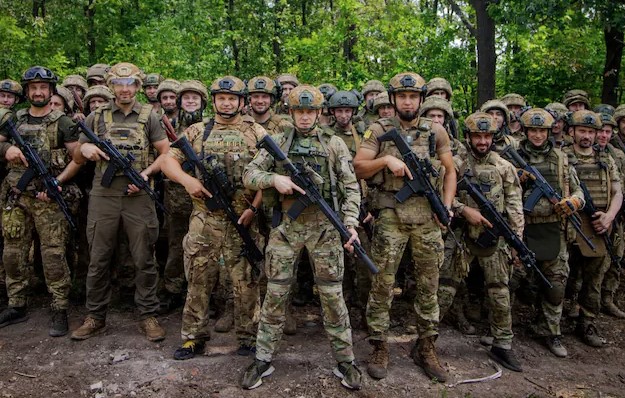One of Ukraine’s most decorated soldiers, Major Oleh Shyriaiev, has created a special uniform to protect soldiers from deadly drone attacks. Known for his bravery and leadership, Major Shyriaiev was recently awarded the highest military honor in Ukraine — the title of Hero of Ukraine.
A New Kind of Uniform for a New Kind of War
This new development comes as the nature of war in Ukraine has changed dramatically. Drones have become a major threat. These small flying machines often drop explosives from the air. When they explode, they release shrapnel — tiny pieces of metal that can injure or kill soldiers nearby.
To fight this danger, Major Shyriaiev designed an “armored combat suit.” Unlike regular body armor, this suit covers more of the body and is built to stop flying shrapnel. The goal is simple: save more lives on the front lines.
Ukraine Endures Deadliest Night of War: 298 Drones, 45 Missiles Rain Terror Across 13 Regions
The suit uses Kevlar — a strong, heat-resistant material that was first used in racing tyres instead of steel. Kevlar is lighter than the ceramic plates found in traditional bulletproof vests. While it’s not the best at stopping bullets, it’s very good at stopping fast-moving bits of metal from explosions.
Major Shyriaiev said his experience with drone warfare is what led him to design this special uniform. He explained that when a drone drops a grenade or explosive, it sends out deadly metal fragments and smoke. These can fly in different directions at different speeds, making it hard for regular gear to offer full protection.
How the Uniform Works to Save Lives
The armored suit created by Major Shyriaiev is more than just a jacket or vest. It’s a full-body outfit that includes reinforced parts for the elbows, knees, and ankles. This extra padding protects areas that are often exposed when soldiers take cover or crawl on the ground.
The fabric used in the suit is being developed to stop shrapnel of certain sizes from penetrating. The aim is to give maximum protection without making the soldier feel too heavy or hot. Designers are also thinking about adding special shoes with soles that can absorb impact from blasts on the ground.
Usually, soldiers only wear full armor if they are doing very risky jobs, like bomb disposal. That’s because heavy armor can make it hard to move quickly and can cause overheating. Russian special forces have sometimes used similar suits in anti-terror missions. But in regular combat, such suits are rare.
Bulletproof vests can be taken off when soldiers need to move fast. These vests mainly protect the chest and back with heavy ceramic plates. They’re good at stopping bullets, but not so much at stopping blasts from drones or artillery.
This new uniform reflects the reality of the war in Ukraine today. Much of the fighting is happening in fixed positions. Soldiers often stay in the same area for a long time. The main danger now comes from above — from drones and artillery — rather than from gunfire. That’s why full-body protection is becoming more important.
Fear in Moldova: Russian Drones Explode Near Villages
Experience and Insights from the Front Line
Major Shyriaiev is no stranger to war. He began his service during the conflict in the Donbas region in 2014, back when drones weren’t a common part of war. Today, drones are everywhere. They have changed the battlefield completely.
He has seen the damage drones can do. Some of the most dangerous drones now use fiber optic cables. These can’t be jammed by electronic signals. They stay connected to their command centers and are very hard to stop. Major Shyriaiev called them “top of the game.”
Still, he believes that no machine can replace a human soldier. “Without infantry, war is impossible,” he said. “A drone cannot replace a person. A soldier makes decisions, fires weapons, and sees the battlefield with human eyes.”
Even in summer, with trees full of leaves that make it hard for drones to see soldiers, human observation is still needed. Major Shyriaiev added that many parts of the military — like reconnaissance teams and frontline observers — all work together to help commanders know what’s happening in real time.
UN confirms 395 civilians killed by drones—buses, balconies, and bikers among targets
Major Shyriaiev also spoke about the wider war. He warned that Russia continues to improve its tactics. Even if Russian troops don’t want to follow orders, they can be forced to, and that helps their side move forward in battle. He called Russia’s goals “predatory,” pointing to threats toward countries like Poland, Moldova, and parts of Finland.
Ahead of a NATO meeting, he said he believed that the EU and the UK would increase their defense spending. This, he said, was necessary to meet the needs of today’s high-tech warfare.
Despite his important role, Major Shyriaiev still makes time for his family. His wife and two children live in Kharkiv. He keeps in touch with them through Facetime and visits them when he can. “I understand that life is passing by,” he said. “But I have an important assignment to fulfil.”
His mission now is clear: protect the troops, finish the war, and return home to his family.

